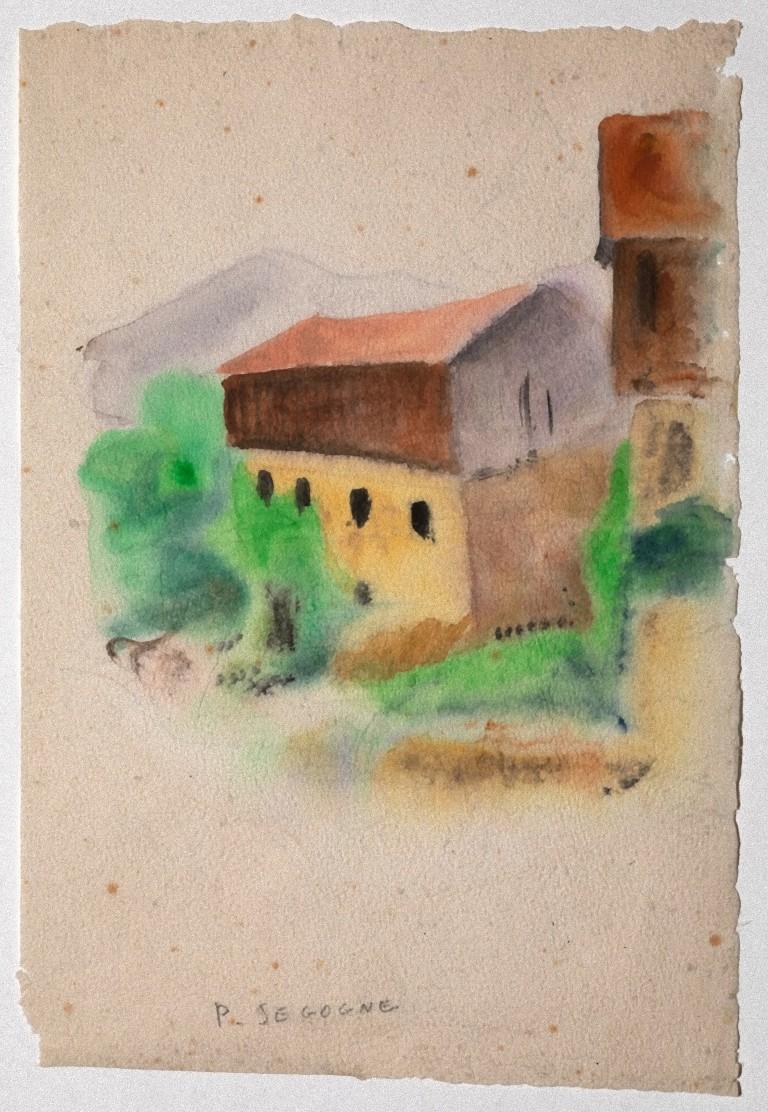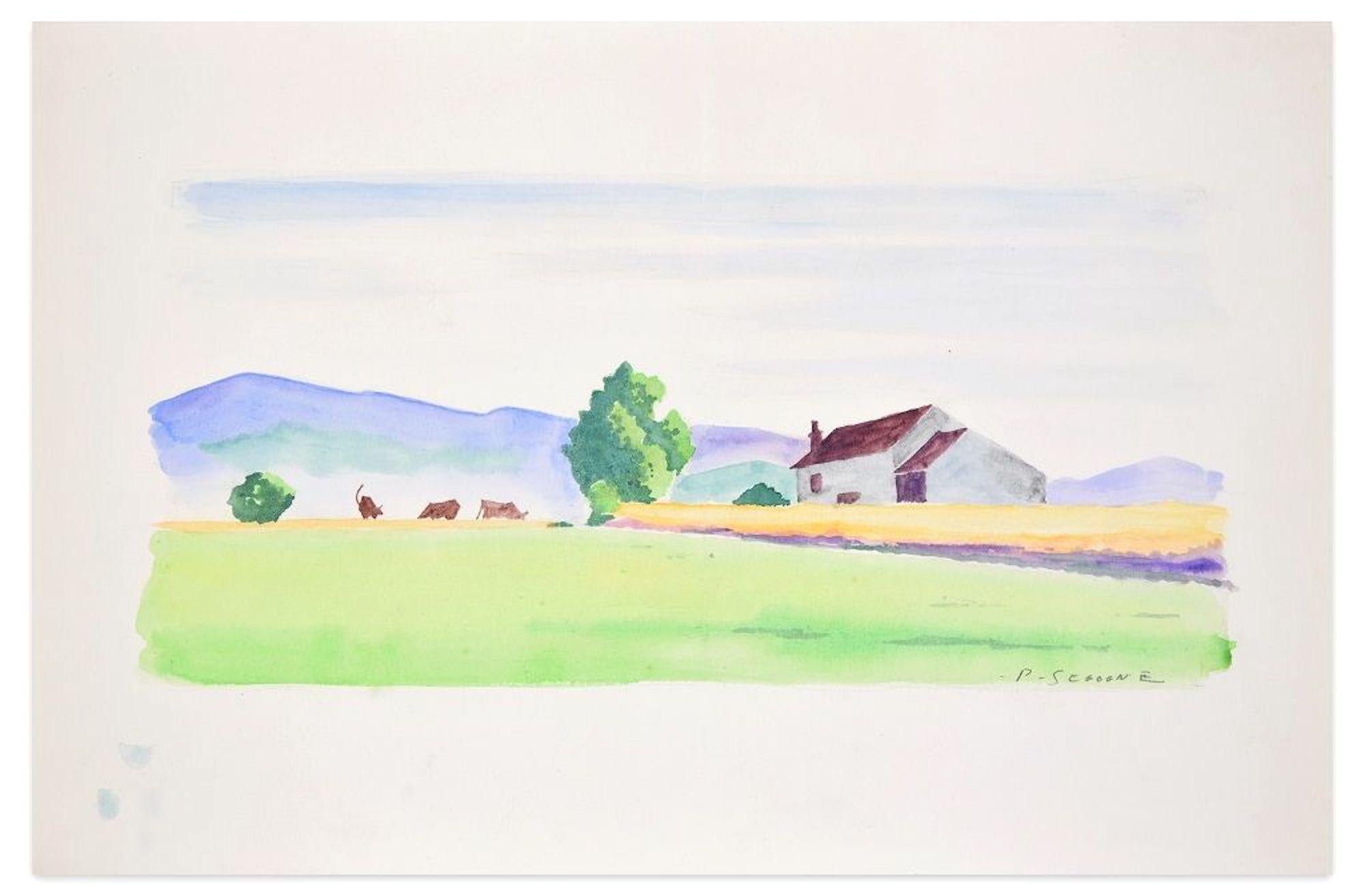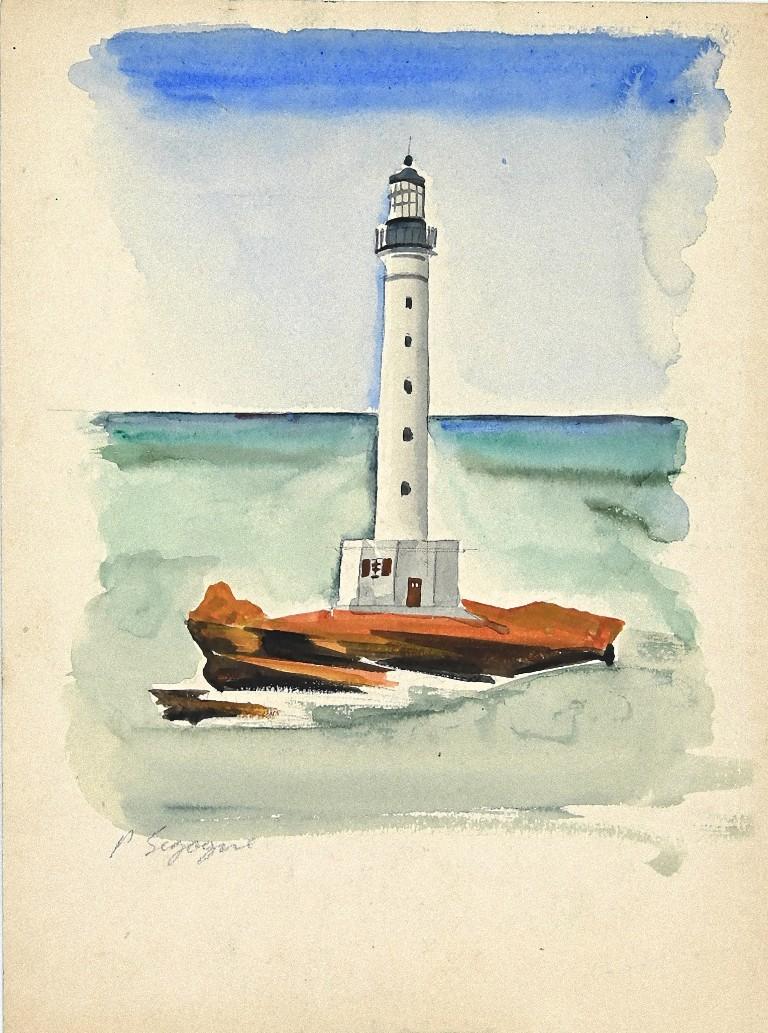Items Similar to Landscape - Original Watercolor by Jean Delpech - 20th Century
Want more images or videos?
Request additional images or videos from the seller
1 of 5
Jean DelpechLandscape - Original Watercolor by Jean Delpech - 20th Century20th Century
20th Century
About the Item
Landscape is an original drawing in watercolor on paper, realized by Jean Delpech (1916-1988).
The state of preservation of the artwork is good except for some rippings and small cutaways at the margins.
Hand-signed on the lower right,1953.
Sheet dimension: 25.5 x 35 cm.
The artwork represents a beautiful landscape with vivid color, joyfully created, through light colors of watercolor.
Jean-Raymond Delpech(1988-1916) is a French painter, engraver and illustrator, who is most influenced by the country of his childhood. he studied at the School of Fine Arts in Paris. He won his first prize of Rome in engraving intaglio in 1948, then gained much success in Italy. He also produced postage stamps, illustrations for books and magazines, theater sets (for Dullin), medals, paintings and even stained glass.
From 1944 to 2004, his work was the subject of numerous exhibitions, individual or collective.
- Creator:
- Creation Year:20th Century
- Dimensions:Height: 10.04 in (25.5 cm)Width: 13.78 in (35 cm)Depth: 0.04 in (1 mm)
- Medium:
- Movement & Style:
- Period:
- Framing:Framing Options Available
- Condition:Insurance may be requested by customers as additional service, contact us for more information.
- Gallery Location:Roma, IT
- Reference Number:Seller: M-1113191stDibs: LU65037157042
About the Seller
4.9
Platinum Seller
These expertly vetted sellers are 1stDibs' most experienced sellers and are rated highest by our customers.
1stDibs seller since 2017
6,839 sales on 1stDibs
Typical response time: 3 hours
- ShippingRetrieving quote...Ships From: Rome, Italy
- Return PolicyA return for this item may be initiated within 14 days of delivery.
Auctions on 1stDibs
Our timed auctions are an opportunity to bid on extraordinary design. We do not charge a Buyer's Premium and shipping is facilitated by 1stDibs and/or the seller. Plus, all auction purchases are covered by our comprehensive Buyer Protection. Learn More
More From This SellerView All
- During the War - Drawing by Jean-Raymond Delpech - 1941Located in Roma, ITDuring the War is an original drawing in watercolor realized in 1941 by Jean-Raymond Delpech (1916-1988). Hand-signed and dated on the lower right. The state of preservation of the...Category
1940s Modern Figurative Drawings and Watercolors
MaterialsWatercolor
- Autumn - Original Drawing by Jean-Raymond Delpech - 1958Located in Roma, ITAutumn is an original is an original drawing in watercolor on cardboard realized by Jean-Raymond Delpech (1916-1988) in 1958. Hand-signed and dated on the lower right. The state of...Category
1950s Modern Figurative Drawings and Watercolors
MaterialsWatercolor
- Mountains - Original Drawing by Jean-Raymond Delpech - 1944Located in Roma, ITMountains is an original drawing in watercolor on cardboard realized by Jean-Raymond Delpech (1916-1988) in 1944. Hand-signed and dated on the lower right. The state of preservatio...Category
1940s Modern Figurative Drawings and Watercolors
MaterialsWatercolor
- Ruins of the Ancient Aqueducts by Carl Friedrich Heinrich Werner - 1872By Carl Friedrich Heinrich WernerLocated in Roma, ITRuins of the Ancient Aqueducts is an original artwork realized by Carl Friedrich Heinrich Werner (Weimar, 4 October 1808 – Leipzig, 10 January 1894) in 1872. Watercolour and pencil on paper. Hand-signed and dated on the lower left corner: C. Werner 1872. Good conditions. Prov. Collection Dr. Peter Nicolaus (1940-2020). Carl Friedrich Heinrich Werner (4 October 1808 – 10 January 1894) was a German...Category
1870s Modern Figurative Drawings and Watercolors
MaterialsWatercolor, Pencil
- French Landscape - Watercolor - Mid-20th CenturyLocated in Roma, ITThe french Landscape is an original drawing in watercolor by an anonymous artist in the early 20th Century. Good conditions. The artwork is depicted through strong strokes in a wel...Category
Mid-20th Century Modern Figurative Drawings and Watercolors
MaterialsWatercolor
- Landscape - Drawing by Jean-Raymond Delpech - Mid-20th centuryBy Jean DelpechLocated in Roma, IT"Landscape" is an original drawing in watercolor on paper, realized by Jean-Raymond Delpech (1916-1988). The state of preservation of the artwork is good and aged with some ripping ...Category
Mid-20th Century Modern Landscape Drawings and Watercolors
MaterialsWatercolor, Paper
You May Also Like
- Modern school, Boats in Palma de Mallorca, watercolorLocated in Paris, FRModern School, Mid 20th century Boats in Palma de Mallorca Watercolor on paper 50 x 36.5 cm Framed : 56.5 x 43 cm The characteristic silhouette of t...Category
1950s Modern Landscape Drawings and Watercolors
MaterialsWatercolor
- GravesendBy James McBeyLocated in Storrs, CTGravesend. August 1928. Ink and watercolor on paper. 13 1/2 x 21. Signed and dated in ink, lower left; and titled in ink, verso. Housed in a 24 1/2 x 31-inch Whistler-style gold frame. Gravesend is a town in northwest Kent, England, on the south bank of the Thames, opposite Tilbury in Essex, about 15 miles southeast of London. Born in Newburgh near Aberdeen, James McBey attended evening classes at Graydon's School of Art and taught himself etching, building his own press at the age of fifteen. He moved to London to prepare for a one-man show at Goupil's Gallery, and shortly after this highly successful first show, he traveled to Morocco with James Kerr Lawson...Category
20th Century Modern Landscape Drawings and Watercolors
MaterialsInk, Watercolor
- Estes Park (Colorado), American Modernist Watercolor PaintingBy James Russell ShermanLocated in Denver, COVintage view of storefronts in Estes Park, Colorado, near Rocky Mountain National Park by James Russell Sherman (1906-1989). Watercolor and ink on paper, signed by the artist in the ...Category
1930s American Modern Landscape Drawings and Watercolors
MaterialsWatercolor
- Rare Chaim Gross Watercolor Painting Manhattan Skyscrapers Train NYC WPA ArtistBy Chaim GrossLocated in Surfside, FLThis appears to be dated 1927. It came in with a piece dated 1929. A very early, rare work. Framed 22.5 x 18. Image 14.5 x 9 A great New York city street scene with an El train (elevated subway line) and architectural renderings of buildings. This is a wonderful piece by one of America's most treasured artists, Chaim Gross. Throughout his lifetime Gross has gone through tragedy and a real test of faith however, he has the unique ability to focus and direct his expression to the most joyful and beautiful works of art, such as the present lot. For more than sixty years Chaim Gross's art has expressed optimistic, affirming themes. His acrobats, cyclists, and mothers and children convey joyfulness, exuberance, love, and intimacy. This aspect of his work remained consistent with his Hasidic heritage, which teaches that "only in his childlike happiness is man nearest to God." He often used his creative abilities to explore and experiment with media. In his artwork he retains an optimistic philosophy, even when facing somber issues such as war, depression, and the Holocaust. Chaim Gross (March 17, 1904 – May 5, 1991) was an American sculptor and educator. Gross was born to a Jewish family in Austrian Galicia, in the village of Wolowa (now known as Mezhgorye, Ukraine), in the Carpathian Mountains. In 1911, his family moved to Kolomyia (which was annexed into the Ukrainian USSR in 1939 and became part of newly independent Ukraine in 1991). When World War I ended, Gross and brother Avrom-Leib went to Budapest to join their older siblings Sarah and Pinkas. Gross applied to and was accepted by the art academy in Budapest and studied under the painter Béla Uitz, though within a year a new regime under Miklos Horthy took over and attempted to expel all Jews and foreigners from the country. After being deported from Hungary, Gross began art studies at the Kunstgewerbeschule in Vienna, Austria shortly before immigrating to the United States in 1921. Gross's studies continued in the United States at the Beaux-Arts Institute of Design, where he studied with Elie Nadelman and others, and at the Art Students League of New York, with Robert Laurent. He also attended the Educational Alliance Art School, studying under Abbo Ostrowsky, at the same time as Moses Soyer and Peter Blume. In 1926 Gross began teaching at The Educational Alliance, and continued teaching there for the next 50 years. Louise Nevelson was among his students at the Alliance (in 1934), during the time she was transitioning from painting to sculpture. In the late 1920s and early 1930s he exhibited at the Salons of America exhibitions at the Anderson Galleries and, beginning in 1928, at the Whitney Studio Club. In 1929, Gross experimented with printmaking, and created an important group of 15 linocuts and lithographs of landscapes, New York City streets and parks, women in interiors, the circus, and vaudeville. The entire suite is now in the collection of the Philadelphia Museum of Art. Gross returned to the medium of printmaking in the 1960s, and produced approximately 200 works in the medium over the next two decades. In March 1932 Gross had his first solo exhibition at Gallery 144 in New York City. For a short time they represented Gross, as well as his friends Milton Avery, Moses Soyer, Ahron Ben-Shmuel and others. Gross was primarily a practitioner of the direct carving method, with the majority of his work being carved from wood. Other direct carvers in early 20th-century American art include William Zorach, Jose de Creeft, and Robert Laurent. Works by Chaim Gross can be found in major museums and private collections throughout the United States, with substantial holdings (27 sculptures) at the Hirshhorn Museum and Sculpture Garden. A key work from this era, now at the Smithsonian American Art Museum, is the 1932 birds-eye maple Acrobatic Performers, which is also only one and one quarter inch thick. In 1933 Gross joined the government's PWAP (Public Works of Art Project), which transitioned into the WPA (Works Progress Administration), which Gross worked for later in the 1930s. Under these programs Gross taught and demonstrated art, made sculptures that were placed in schools and public colleges, made work for Federal buildings including the Federal Trade Commission Building, and for the France Overseas and Finnish Buildings at the 1939 New York World's Fair. Gross was also recognized during these years with a silver medal at the Exposition universelle de 1937 in Paris, and in 1942, with a purchase prize at the Metropolitan Museum of Art's "Artists for Victory" exhibition for his wood sculpture of famed circus performer Lillian Leitzel. In 1949 Gross sketched Chaim Weizmann, President of Israel, at several functions in New York City where Weizmann was speaking, Gross completed the bust in bronze later that year. Gross returned to Israel for three months in 1951 (the second of many trips there in the postwar years) to paint a series of 40 watercolors of life in various cities. This series was exhibited at the Jewish Museum (Manhattan) in 1953. In the 1950s Gross began to make more bronze sculptures alongside his wood and stone pieces, and in 1957 and 1959 he traveled to Rome to work with famed bronze foundries including the Nicci foundry. At the end of the decade Gross was working primarily in bronze which allowed him to create open forms, large-scale works and of course, multiple casts. Gross's large-scale bronze The Family, donated to New York City in 1991 in honor of Mayor Ed Koch, and installed at the Bleecker Street Park at 11th street, is now a fixture of Greenwich Village. In 1959, a survey of Gross's sculpture in wood, stone, and bronze was featured in the exhibit Four American Expressionists curated by Lloyd Goodrich at the Whitney Museum of American Art, with work by Abraham Rattner, Doris Caesar, and Karl Knaths. In 1976, a selection from Gross's important collection of historic African sculpture, formed since the late 1930s, was exhibited at the Worcester Art Museum in the show The Sculptor's Eye: The African Art Collection of Mr. and Mrs. Chaim Gross. Gross was elected into the National Academy of Design as an Associate member, and became a full Academician in 1981. In 1984, he was inducted into the American Academy of Arts and Letters, with Jacob Lawrence and Lukas Foss. In the fall of 1991, Allen Ginsberg gave an important tribute to Gross at the American Academy of Arts and Letters, which is published in their Proceedings. In 1994, Forum Gallery, which now represents the Chaim Gross estate, held a memorial exhibition featuring a sixty-year survey of Gross's work. Gross was a professor of printmaking and sculpture at both the Educational Alliance and the New School for Social Research in New York City, as well as at the Brooklyn Museum Art School, the MoMA art school, the Art Student's League and the New Art School (which Gross ran briefly with Alexander Dobkin...Category
Mid-20th Century American Modern Figurative Drawings and Watercolors
MaterialsPaper, Watercolor
- "Muir Woods", Sunlit Redwoods Figurative Landscape Watercolor by Jill PlessLocated in Soquel, CA"Muir Woods", Sunlit Redwoods Figurative Landscape Watercolor by Jill Pless Luminous figurative landscape featuring towering redwood trees with rays of sun...Category
Late 20th Century Modern Landscape Drawings and Watercolors
MaterialsWatercolor, Paper
- Crashing Waves on Atlantic Coast, Mid-century Seascape, Cleveland School ArtistBy Frank WilcoxLocated in Beachwood, OHFrank Nelson Wilcox (American, 1887-1964) Crashing Waves on the Atlantic Coast, 1957 Watercolor and graphite on paper Signed and dated lower right 22 x 29 inches Frank Nelson Wilcox (October 3, 1887 – April 17, 1964) was a modernist American artist and a master of watercolor. Wilcox is described as the "Dean of Cleveland School painters," though some sources give this appellation to Henry Keller or Frederick Gottwald. Wilcox was born on October 3, 1887 to Frank Nelson Wilcox, Sr. and Jessie Fremont Snow Wilcox at 61 Linwood Street in Cleveland, Ohio. His father, a prominent lawyer, died at home in 1904 shortly before Wilcox' 17th birthday. His brother, lawyer and publisher Owen N. Wilcox, was president of the Gates Legal Publishing Company or The Gates Press. His sister Ruth Wilcox was a respected librarian. In 1906 Wilcox enrolled from the Cleveland School of Art under the tutelage of Henry Keller, Louis Rorimer, and Frederick Gottwald. He also attended Keller's Berlin Heights summer school from 1909. After graduating in 1910, Wilcox traveled and studied in Europe, sometimes dropping by Académie Colarossi in the evening to sketch the model or the other students at their easels, where he was influenced by French impressionism. Wilcox was influenced by Keller's innovative watercolor techniques, and from 1910 to 1916 they experimented together with impressionism and post-impressionism. Wilcox soon developed his own signature style in the American Scene or Regionalist tradition of the early 20th century. He joined the Cleveland School of Art faculty in 1913. Among his students were Lawrence Edwin Blazey, Carl Gaertner, Paul Travis, and Charles E. Burchfield. Around this time Wilcox became associated with Cowan Pottery. In 1916 Wilcox married fellow artist Florence Bard, and they spent most of their honeymoon painting in Berlin Heights with Keller. They had one daughter, Mary. In 1918 he joined the Cleveland Society of Artists, a conservative counter to the Bohemian Kokoon Arts Club, and would later serve as its president. He also began teaching night school at the John Huntington Polytechnic Institute at this time, and taught briefly at Baldwin-Wallace College. Wilcox wrote and illustrated Ohio Indian Trails in 1933, which was favorably reviewed by the New York Times in 1934. This book was edited and reprinted in 1970 by William A. McGill. McGill also edited and reprinted Wilcox' Canals of the Old Northwest in 1969. Wilcox also wrote, illustrated, and published Weather Wisdom in 1949, a limited edition (50 copies) of twenty-four serigraphs (silk screen prints) accompanied by commentary "based upon familiar weather observations commonly made by people living in the country." Wilcox displayed over 250 works at Cleveland's annual May Show. He received numerous awards, including the Penton Medal for as The Omnibus, Paris (1920), Fish Tug on Lake Erie (1921), Blacksmith Shop (1922), and The Gravel Pit (1922). Other paintings include The Trailing Fog (1929), Under the Big Top (1930), and Ohio Landscape...Category
1950s American Modern Figurative Drawings and Watercolors
MaterialsGraphite, Watercolor
Recently Viewed
View AllMore Ways To Browse
Italian Painters 20th Century
Vintage Postage Stamps
Theater Set
Original Intaglio
Rome Engraving Landscape
Landscape Engravings Set
Carole Callahan
Chang Dai Chien
Dolona Roberts
Dougal Anderson
Douglas Ion Smart, R.E. On Sale
Douglas Pinder
E Saville
Emily Farish
Fernand Guignier On Sale
G D Paulraj
Gary Haven Smith
George Drummond Fish





